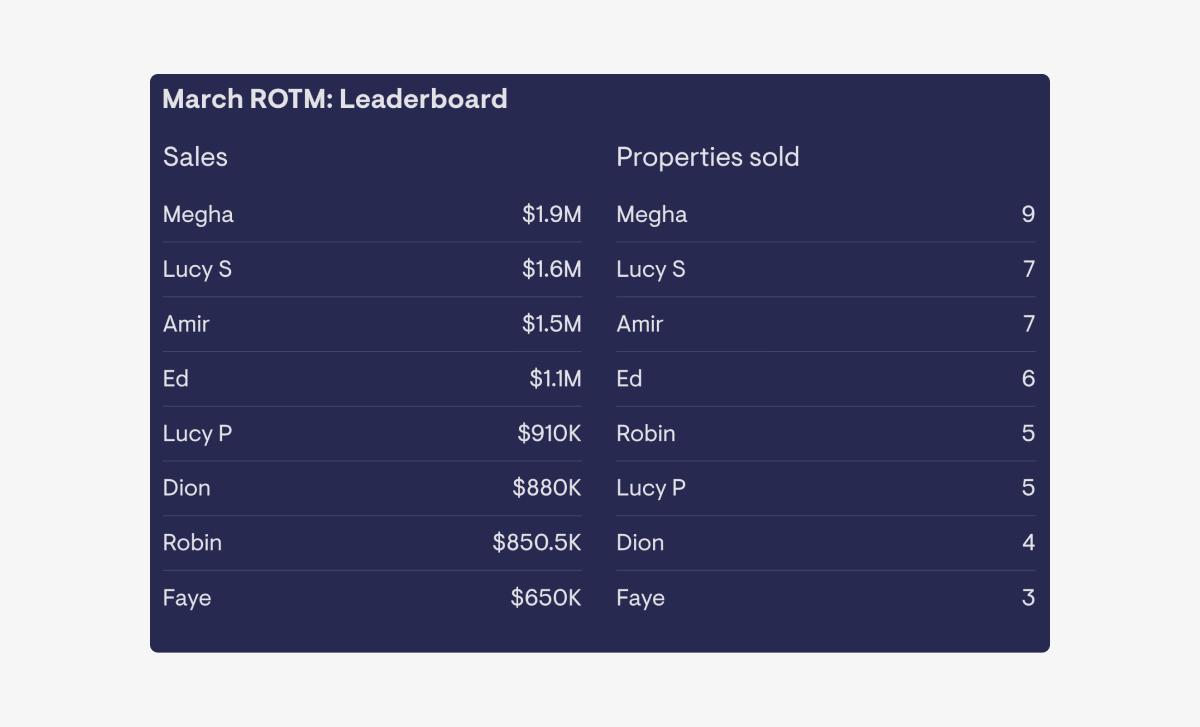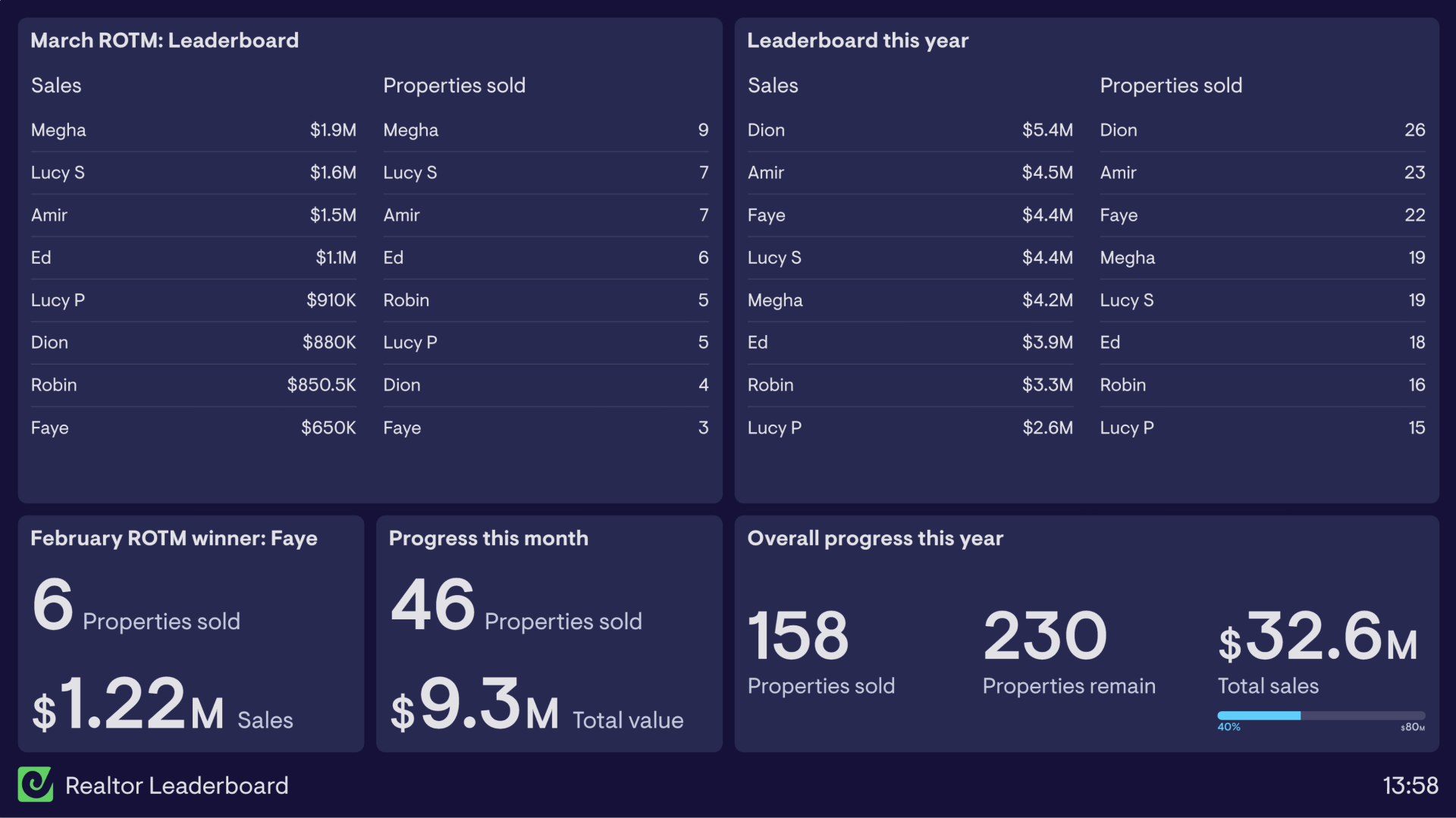In this post we explore sales leaderboards by discussing how they work, key benefits, and how you can implement them within your sales team.
What is a sales leaderboard?
A sales leaderboard is a visual representation of individual sales team member performance. A leaderboard ranks sales reps based on specific goals, such as the value of deals closed.
Sales leaderboards can come in many different forms, from spreadsheets, to real-time data dashboards. The key thing is that they’re updated regularly so the sales team are able to feel the benefits of “climbing the leaderboard”.
How does a sales leaderboard work?
A sales leaderboard can rank your team based on any of your key metrics. Leaderboards are particularly helpful for motivating sales reps when it comes to important individual goals.
Here’s an example of two leaderboards being used by a sales team at a real estate company.

These sales leaderboards are being used to track the Realtor Of The Month (ROTM). One leaderboard shows the total sales value the realtor has brought in for the month and the other shows the number of properties sold.
This leaderboard helps everyone to see where they are in comparison to their peers and breeds healthy competition among those working hard to get Realtor Of The Month. By breaking out the two KPIs, sales value and properties sold, team members are able to identify what they might need to work on in order to rank higher on the board.
What are the benefits of a sales leaderboard?
Competition
A sales team is often one of the more competitive environments within a business. Therefore sales leaderboards naturally play into this; they breed healthy competition by sharing individual performances alongside one another. Allowing team members to see how they shape up and what they need to do to improve.
Motivation
With competition in mind, sales leaderboards can be hugely motivational. By inspiring competition, team members are motivated to hit the first place on the leaderboard.
Gamification
Sales leaderboards are often used to gamify some of the less exciting tasks that a sales team performs on a regular basis. If your team needs to cold call, a leaderboard can encourage them to complete more cold calls in a day as they see their performance moving them up the leaderboard.
(We often hear of customers gamifying their leaderboards further by adding extra incentives for those who top the leaderboard such as free pizza or leaving the office an hour earlier than everyone else.)
Geckoboard has made a huge impact on our sales and our team’s psychology. They can see how far away they are from their targets – if they’re only a few percent off, there’s a big drive to hit them on time. Vaughn Newton - Business Development Manager at Dymatec
Accountability
When key sales information is being shared within the team it promotes accountability. A leaderboard helps team members to be accountable to themselves and the wider team for what they’ve achieved.
Visibility
And finally, by bringing KPIs into a public space with a leaderboard, you’re increasing the visibility of individual and team performance in a way that perhaps hasn’t existed before. It allows recognition to flow through the team to those who deserve it.
How can I set up a sales leaderboard?
First of all, you’ll need to determine the sales metrics that would have the most impact on your team if they were included in a leaderboard.
Often sales leaderboards are based around sales activity metrics where you’re trying to encourage reps to complete specific tasks with a higher conversion rate such as presentations. They can also be based on outcome metrics which highlight to the individuals and the team how they’re performing against goals such as sales revenue. This is a good choice when you have sales reps receiving bonuses based on the sales revenue they bring in.
Once you’ve figured out the best metrics for your leaderboards, you just need to visualize that data. Here are a few ways to roll out sales leaderboards for your team.
Whiteboard
Despite it being the most manual and most old school method on this list, it’s still extremely popular. A good old fashioned whiteboard may just do the trick if you want to test the impact of sharing a sales leaderboard with your team.
Quite simply, list out your sales team and update the metric (as often as possible ideally) on the whiteboard.
Top tip – get sales reps to update the whiteboard themselves when their numbers change. It takes the load off one person and again puts accountability with the rep.
The drawback for this method is that when things are going well, and there is a lot of activity happening, the whiteboard will need constant updates. A nice problem to have but probably one you want to avoid for fast-changing sales activity metrics, such as cold calls.
Spreadsheet
A spreadsheet is a great way to build a more automated sales leaderboard. You can use pivot tables to automatically rank your sales reps performance and tools such as Zapier to automatically pull your data from other places into your spreadsheet.
Top tip — keep your spreadsheet as clean as possible. You don’t want to complicate or confuse things by having huge tables of data in here that make it hard for your sales reps to see what is happening. Ideally have one page with just the leaderboards for your sales team.
A downside of spreadsheets compared to the whiteboard is that they’re not very visible. The onus falls to the Sales Manager to share and encourage sales reps to use a leaderboard within a spreadsheet.
Dashboard tool – Geckoboard
Finally, a dashboard tool such as Geckoboard can be a great way to clearly and automatically visualize your sales leaderboards.
The benefit of using a dashboard tool like Geckoboard is that you can visualize not only sales leaderboards but also other KPIs that help your sales team to perform. Dashboards will update automatically – no need to run for the whiteboard pen – and will refresh within minutes so your data is always up-to-date.

With Geckoboard, you can connect directly to Sales tools such as Salesforce, Pipedrive, and HubSpot with no coding required. If your data lives elsewhere, you can also connect spreadsheets and internal databases. Connecting your data can remove the manual updating required for other methods.
Finally, you’ll always be able to get eyes on your dashboards. Geckoboard has been designed to look great on TV screens, so if your team works in the office you can share professional dashboards for all to see. If your team works remotely, you’ll be able to share dashboards via a sharing link but also set up scheduled snapshots via email or Slack as a reminder to check performance.
Want to build a sales leaderboard with Geckoboard? Give it a go with a 14-day free trial.

